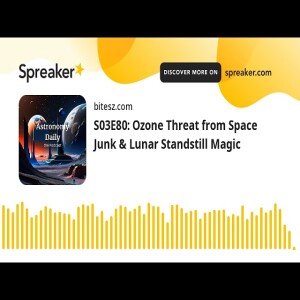
Source:
https://www.spreaker.com/episode/s03e80-ozone-threat-from-space-junk-lunar-standstill-magic--60445936
Embark on a celestial journey with today's episode of Astronomy Daily - The Podcast, where your host, Anna, brings you the latest cosmic updates. We'll explore the first major lunar standstill in 18 years, unveiling a breathtaking celestial moment you won't want to miss. Next, we'll dive into the rich, metallic landscapes of Mars, painting a vivid picture of the red planet's geological marvels. We'll also tackle the unsettling reality of space junk and its impact on Earth's ozone layer, a concern growing with the expansion of satellite mega constellations. Shifting our gaze to Saturn's moon Titan, we'll uncover how wave activity might be shaping its mysterious coastlines. Finally, we'll explore how cosmic winds driven by supermassive black holes can alter the very fabric of galaxies. And to round it all off, we'll get an update on the latest developments at SpaceX's Starbase. So let's dive right in.This year marks a truly remarkable celestial event, the first major lunar standstill since 2006. This fascinating phenomenon will see the moon rising and setting at its most extreme points on the horizon. For sky watchers, this is a rare treat, occurring only once every 18.6 years. During a major lunar standstill, the tilts of both the Earth and the moon are at their maximum, causing the moon to rise and set at its highest and lowest points in its orbital cycle. To fully appreciate the grandeur of this event, consider the ancient sites of Stonehenge, Kalanish, and Newgrange. These prehistoric monuments are thought to be aligned with the points of moonrise and moonset during such standstills, indicating the historical significance and awe that this event has invoked in humanity for millennia. The next standstill, at its most extreme, will be around the equinoxes in September 2024 and March 2025. For those eager to witness this spectacle, the best times include moonrise at sunset and moonset at sunrise, especially during a full moon. No need for elaborate equipment, just a clear view of the horizon will suffice to observe the moon's dramatic paths. So mark your calendars and be sure to look up. The lunar sky is about to put on a show you won't want to miss.The European Space Agency has recently unveiled a breathtaking image of Mars' Marth Vallis region, highlighting the planet's complex and metallic beauty. This newly captured scene showcases landscapes rich in iron, magnesium, and aluminum, creating a vibrant and rust-colored spectacle that tells a story billions of years in the making. Marth Vallis is particularly significant because it bears evidence of ancient water flow. The region's deeply eroded valleys and mineral-rich layers suggest that liquid water once roamed these Martian plains, potentially creating habitable conditions. This discovery continues to intrigue scientists as understanding the history of water on Mars is crucial for piecing together the planet's potential for supporting life. With ongoing studies and future missions focused on similar areas, we inch closer to unlocking the mysteries of the red planet's wet past and its capacity to host life.A new study has quantified the alarming extent of pollution caused by defunct Internet satellites. Thousands of satellites have been deployed into mega constellations to meet the growing global demand for Internet services. However, when these satellites reach the end of their operational life and re-enter Earth's atmosphere, they disintegrate and release aluminum oxide particles that erode the ozone layer. This phenomenon poses a significant threat to the years of progress made in ozone recovery. The 1987 Montreal Protocol successfully curbed the emission of ozone-depleting substances like CFCs, leading to a shrinking ozone hole over Antarctica, with full recovery expected within the next few decades. But now the unexpected increase in aluminum oxide pollution could derail this positive trend. The study, published in Geophysical Research Letters, shows that aluminum oxide particles initiate chemical reactions between ozone and chlorine, leading to sustained ozone depletion. Alarmingly, the number of aluminum oxide particles in the atmosphere has surged eightfold from 2016 to 2022. This spike is set to continue as companies like SpaceX and Amazon plan to launch thousands more satellites. The ongoing and upcoming mega constellations are estimated to significantly elevate aluminum levels in the mesosphere, thereby posing a long-term threat to the stratospheric ozone layer, which shields us from harmful UV radiation. The researchers emphasize the need for immediate attention to this growing issue, advocating for sustainable practices to limit satellite-driven ozone depletion. The results underline the importance of balancing technological advancement with environmental stewardship to ensure our atmosphere remains protective for generations to come
More Episodes
Create your
podcast in
minutes
- Full-featured podcast site
- Unlimited storage and bandwidth
- Comprehensive podcast stats
- Distribute to Apple Podcasts, Spotify, and more
- Make money with your podcast
It is Free
- Privacy Policy
- Cookie Policy
- Terms of Use
- Consent Preferences
- Copyright © 2015-2024 Podbean.com








